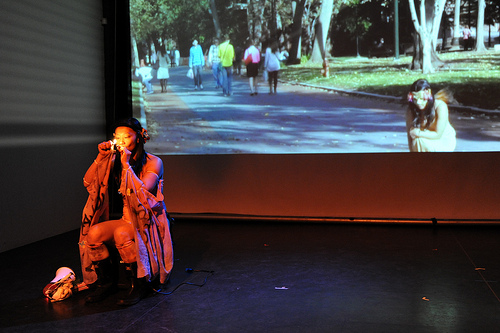
Soomi Kim and Suzi Takahashi’s CHANG(E) examines the performance artist and political activist Kathy Change’s bizarre end
HERE
145 Sixth Ave. at Dominick St.
November 4-22, $18
212-647-0202
here.org
Korean-born, New York-based movement artist Soomi Kim and director Suzi Takahashi complete their trilogy of multidisciplinary works about underrecognized Asian American figures with Chang(e), running November 4-22 at HERE, where it was previously part of the CultureMart festival. Dictee: bells fall a peal to sky explored the stories of such women as Joan of Arc and Yu Guan Soon, while Lee/gendary deconstructed martial arts icon Bruce Lee. In Chang(e), which was developed through the HERE Artist Residency Program, Kim and Takahashi examine what led Ohio-born performance artist and activist Kathleen Chang, also known as Kathy Change, to kill herself in a public act of self-immolation on the Penn campus in 1996. The multimedia docudrama, which combines dance, text, video, and live music, is performed by Kim, Ben Skalski, Kiyoko Kashiwagi, David Perez-Ribada, Criena House, Adriana Spencer, and Zeke Stewart, with music by Adam Rogers, set design by Bryce Cutler, video by Kevan Loney, lighting by Lucrecia Briceno, costumes by Machine Dazzle, and choreography by Alexandra Belle. To prepare for the HERE shows, Kim and Loney went to Philadelphia to visit some of the places where Kathy Change lived and performed and shoot video for the project. In putting the work together, Kim and Takahashi explain, “We discovered that Kathy was a passionate, marginalized woman, battling her own cultural and psychological demons, who aspired to save the world through political transformation. After two years of struggling to reconstruct these stories and fragments into a play, we realized that we were no closer to learning any absolute truths about Kathy. Instead, our show marks the canvas with a few brushstrokes to allow just enough form to emerge so the audience may fill in the details of Kathy’s life with their imaginations. By showing fragments, impressions, and fictions in response to her legacy, we seek to uncover a universal meaning to her life that is inspired by Kathy, but not the truth of her.” (You can find out more about Kathy’s life and legacy here.)